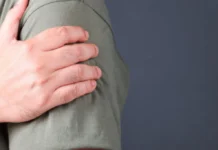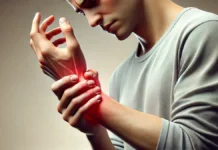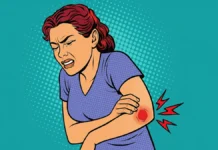Any repeated activity, professional or recreational, can lead to an overuse injury. This type of injury occurs when repeated microtrauma overloads a tissue’s ability to repair itself.
ntroduction
Overuse injuries, also known as overuse or overload injuries, often occur due to repetitive, excessive, or poorly performed physical activity. These injuries typically result from cumulative strain on body tissues, such as muscles, tendons, ligaments, or joints. Here are some common examples of overuse injuries:
- Tendonitis: Tendonitis is an inflammation of the tendon, usually caused by repetitive movements or overuse of a specific muscle. The tendons, which attach muscles to bones, can become inflamed and cause pain and swelling.
- Epicondylitis: Also known as “tennis elbow” or “golfer’s elbow,” epicondylitis is an inflammation of the tendons on the outside or inside of the elbow. It often occurs due to repetitive movements of the wrist and hand.
- Iliotibial Band Syndrome (ITBS): This overuse injury often affects runners and cyclists. The iliotibial band, a large tendon located on the outside of the thigh, can become inflamed due to repeated friction on the knee bone.
- Plantar fasciitis: An inflammation of the plantar fascia, the tissue that connects the heel to the toes. It is often caused by excessive tension on the fascia due to running, walking or wearing inappropriate shoes.
- Muscle Injuries: Muscles can become torn or injured due to overuse or fatigue. This can include muscle sprains or repetitive strain injuries.
- Stress Fractures: Stress fractures can occur when bones are subjected to repeated loading without adequate time to recover. Runners and impact athletes like dancers are particularly prone to these fractures.
- Tendinopathies: In addition to inflammation, constant overuse can cause degenerative changes in the tendons, leading to chronic tendinopathies.
Causes
Overuse injuries, also known as overuse injuries, are often the result of repeated strain or overuse of a body part. Several factors contribute to these injuries, ranging from the work environment to individual habits. One of the major causes is the constant repetition of movements. Repetitive tasks, whether they involve handling heavy objects, typing on a keyboard, or specific gestures in particular sports, can place excessive strain on muscles, tendons, and joints, leading to injuries over time .
Another common source of overuse injuries is improper work postures. Prolonged or uncomfortable positions can cause muscle tension and imbalances, increasing the risk of injury. This especially applies to jobs involving heavy computer use, where poor ergonomics can contribute to problems such as carpal tunnel syndrome or neck and back pain.
Pressure on the body can also come from using poorly fitted equipment. Tools, instruments or equipment that are not adapted to the individual body shape can cause excessive strain and strain, increasing the likelihood of injury. Lack of adequate breaks while working also contributes to overuse injuries. Lack of time for rest and recovery leaves little opportunity for the body to recover from the stresses experienced, increasing the risk of long-term injury.
The psychological factor also plays a crucial role. Job stress, high demands, and pressure to achieve goals can lead to high levels of mental and emotional tension. These psychological tensions often manifest physically, increasing the likelihood of muscle tightness, headaches, and other symptoms related to overwork.
An important element to consider is insufficient physical preparation. In sporting or physically demanding activities, a lack of adequate conditioning increases vulnerability to overuse injuries. Unprepared muscles or weak joints are more likely to give way under pressure, leading to sprains, muscle strains, or other injuries.
List of causes
Symptoms
The symptoms of overuse injuries are varied, often insidious and can change over time. One of the most common signs is persistent pain. Affected areas, whether muscles, tendons or joints, may emit constant signals of discomfort, dull pain or burning sensation. This pain may be localized or spread over a larger area depending on the specific nature of the overuse injury.
Stiffness or decreased joint flexibility can also be a common symptom. Movements that were once smooth may become difficult, and there may be a feeling of tension or resistance when performing normal activities. This stiffness can be particularly pronounced after periods of inactivity, such as in the morning after a night’s sleep.
Neurological disorders, such as tingling, numbness, or tingling sensations, may also occur. These symptoms may indicate nerve compression due to inflammation or pressure from surrounding tissues resulting from repetitive movements or awkward positions.
Another symptom to watch out for is excessive muscle fatigue. If muscles are constantly used without adequate rest periods, they can quickly become exhausted, leading to persistent fatigue. This may manifest as a feeling of weakness, difficulty maintaining certain positions, or even muscle tremors.
Overuse injuries can also influence sleep. Constant pain or physical discomfort can disrupt nighttime rest, leading to problems with insomnia or difficulty finding a comfortable position to sleep.
Emotionally, these injuries can cause stress and anxiety. Frustration with persistent pain and physical limitations can impact mental well-being, even leading to episodes of depression in some cases.
It is crucial to note that the symptoms of overuse injuries can vary in intensity and manifestation from person to person. Some individuals may experience subtle symptoms at first, while others may experience intense, immediate pain. Additionally, the chronicity of symptoms may differ, ranging from intermittent pain to persistent discomfort.
List of symptoms
Pathophysiology
The pathophysiology of overuse injuries lies in excessive stress and repeated strain placed on the anatomical structures of the body. These injuries can affect muscles, tendons, ligaments and joints, often resulting from overuse or repetitive movements. One of the main pathways involved in these injuries is mechanical overload. Repetitive movements, such as frequent flexion or extension of joints, can lead to progressive fatigue and degeneration of the tissues involved.
At the muscular level, constant overuse can cause repetitive strain injuries. These microtraumas can trigger local inflammation, stimulating the release of pro-inflammatory chemicals. This chronic inflammation can lead to a cascade of cellular responses, contributing to pain, stiffness and loss of muscle function.
Tendons, which connect muscles to bones, are particularly prone to overuse injuries. Repetitive movements can lead to microtears in the tendon fibers, triggering an inflammatory response. If this inflammation persists, it can lead to tendinopathy, characterized by degeneration of the tendon and a reduction in its ability to support load.
Ligaments, which connect bones together, are also vulnerable to overuse injuries, especially with excessive or repetitive movements. The constant forces applied to ligaments can cause them to overstretch or even tear, increasing the risk of ligament laxity and associated pain.
Joints, where bones meet, can experience excessive stress with repetitive movements. This can lead to breakdown of joint cartilage, leading to inflammation and pain associated with osteoarthritis.
The pathophysiology of overuse injuries also involves changes at the neurological level. Constantly repeating movements can lead to continued activation of sensory nerve fibers, causing hypersensitivity and increased pain sensations. Additionally, nerve compression resulting from inflammation of surrounding tissues can contribute to neurological symptoms such as tingling, numbness, or tingling sensations.
The influence of psychosocial factors should not be neglected in the pathophysiology of overuse injuries. Chronic stress can act as a modulator, exacerbating inflammation and pain sensitivity. High levels of stress can also influence sleep patterns, nutrition and recovery, impacting the body’s ability to heal and resist physical stress.
List
Most Common Diagnoses and Locations of Chronic Tendonitis
Chronic tendonitis is persistent inflammation of a tendon that can result from prolonged wear and tear, overuse or repetitive injury. Tendons are the fibrous tissues that connect muscles to bones. Here are some common diagnoses and locations associated with chronic tendonitis:
- Achilles tendonitis: Achilles tendonitis affects the Achilles tendon, which connects the calf muscles to the heel bone. It often occurs in people who do activities that require frequent pressure on this tendon, such as running.
- Patellar tendonitis (or quadriceps tendonitis): This involves inflammation of the tendon that connects the kneecap (patella) to the quadriceps muscles of the thigh. Activities that frequently put stress on the knees, such as jumping, can contribute to this tendinitis.
- Elbow tendonitis (epicondylitis): There are two types of epicondylitis: lateral tendonitis (tennis elbow) and medial tendonitis (golfer’s elbow). These conditions result from inflammation of the tendons surrounding the elbow, usually due to repetitive movements of the wrist or hand.
- Shoulder tendonitis: This is an inflammation of the shoulder tendons, particularly the supraspinatus tendon. Shoulder tendinitis can be caused by repetitive movements of the arm overhead, such as those performed in certain sports or occupations.
- Wrist tendonitis (De Quervain’s tendonitis): This tendonitis affects the tendons of the thumb and wrist, causing pain near the base of the thumb. It is often associated with repetitive movements of the thumb and wrist.
- Biceps tendonitis: Inflammation of the biceps tendon, which attaches to the arm bone, can result from repetitive lifting or heavy lifting.
- Jumper’s knee tendonitis: This tendinitis affects the patellar tendon, located below the kneecap, and commonly occurs in athletes involved in jumping activities, such as jump rope or basketball.
Understanding Muscle Tension Linked to Overwork
- The Mechanisms of Muscle Tension linked to Overwork:
- has. Stress Response: Overexertion triggers the release of cortisol and other stress hormones, causing involuntary muscle contraction.
- b. Physical Overload: Excessive physical demands on the body, such as strenuous work or prolonged poor posture, can lead to overstimulation of muscles.
- vs. Emotional Tensions: Emotional overwork creates psychosomatic tension, directly affecting muscle tone.
- Impact on the Musculoskeletal System:
- has. Muscle Contractions: Tight muscles can lead to pain, stiffness and limitations in movement.
- b. Joint Dysfunctions: Excessive muscle tension can disrupt joint alignment, leading to problems such as joint dysfunction.
- Osteopathic approach:
- has. Overall Assessment: Osteopaths carry out a comprehensive assessment of the patient, identifying areas of muscle tension and examining movement patterns.
- b. Structural Manipulation: Gentle manipulation techniques are used to release muscle tension, restore balance and improve joint mobility.
- vs. Postural and Lifestyle Advice: Osteopaths provide personalized advice on posture, ergonomics and other lifestyle factors to prevent recurring muscle tension.
- Preventive Management: a. Regular Sessions: Regular osteopathic sessions can help prevent the accumulation of muscular tension and maintain musculoskeletal balance. b. Relaxation Techniques: Osteopathy incorporates relaxation approaches to help reduce overall stress, thus contributing to the management of muscular tension.
Osteopathy and Overwork: A Winning Duo for Muscle Stress Management
- Personalized Assessment:
- has. The osteopath carries out a thorough assessment, taking into account the patient’s medical history, lifestyle and postural habits.
- b. Identifying specific areas of muscle tension linked to overwork allows a targeted approach.
- Gentle Manipulation and Release of Tension:
- has. Osteopathic techniques, such as joint manipulations and gentle stretching, are used to release accumulated muscle tension.
- b. The manipulation promotes blood circulation, thus contributing to the reduction of inflammation and muscle relaxation.
- Restoration of Postural Balance:
- has. Osteopathy aims to restore postural balance by correcting musculoskeletal imbalances caused by overwork.
- b. Structural adjustments help prevent muscular compensations that can worsen muscle stress.
- Global Stress Management:
- has. Osteopaths integrate relaxation and breathing techniques to reduce overall stress, thereby positively influencing muscular stress.
- b. A holistic approach promotes mental and physical relaxation, complementary to the management of overwork.
- Preventive and Lifestyle Advice:
- has. Osteopaths provide personalized advice on posture, ergonomics and other aspects of daily lifestyle to prevent the recurrence of muscle tension.
- b. Recommendations on stress management, sleep quality and physical activity can be integrated for a comprehensive approach.
- Integration into a Global Strategy:
- has. Osteopathy works synergistically with other stress management approaches, such as psychotherapy, yoga or meditation.
- b. Collaboration between health professionals allows holistic management of overwork and its effects on the body.
Osteopathic Diagnosis of Muscle Tension: Recognizing the Signals of Overwork
- In-depth Clinical Interview:
- has. The osteopath conducts a detailed interview to understand the patient’s medical history, stress level, work habits, and physical activities.
- b. Information on the triggering circumstances of overwork helps to establish links between muscle tension and stressors.
- has. The osteopath conducts a detailed interview to understand the patient’s medical history, stress level, work habits, and physical activities.
- Postural Assessment:
- has. The osteopath carefully observes the patient’s posture when standing, sitting and moving. b. Postural imbalances, often exacerbated by overwork, are essential indicators of muscular tension.
- Analysis of Movement Patterns:
- has. Osteopaths assess the way the patient moves, identifying asymmetries and movement restrictions.
- b. Abnormal movement patterns can indicate specific areas of muscle tension associated with overexertion.
- Palpation and Localization of Tensions:
- has. Manual palpation is used to identify areas of muscle tension, assessing tissue texture, temperature and tenderness.
- b. Trigger points or tense areas are often characteristic of muscle tension linked to overwork.
- Joint Mobility Tests:
- has. The osteopath performs joint mobility tests to assess movement restrictions and joint dysfunctions associated with muscle tension.
- b. Movement limitations can be correlated with areas of muscle tension.
- Assessment of Muscle Chains:
- has. The osteopath examines the muscle chains, identifying imbalances that may result from overwork.
- b. The analysis of muscle chains allows us to understand the propagation of tensions throughout the body.
- Response to Osteopathic Treatment:
- has. The patient’s reaction to osteopathic manipulations is taken into account to assess the effectiveness of the treatment.
- b. A positive response often indicates a correlation between muscle tension and overwork.
Preventive Approaches: How Osteopathy Can Prevent Muscle Tension Induced by Overwork
- Personalized Overwork Risk Assessment:
- Osteopaths perform a thorough assessment of the patient to understand their lifestyle, work habits, stress levels and other risk factors.
- This assessment makes it possible to anticipate situations likely to cause overwork and to implement preventive strategies.
- Correction of Postural Imbalances:
- Postural imbalances can result from spending long hours in an uncomfortable position at work. Osteopathy intervenes to correct these imbalances and promote optimal posture.
- Regular adjustments help maintain healthy posture, thereby reducing muscle tension.
- Education on Postural and Life Hygiene:
- Osteopaths provide advice on postural hygiene, including how to sit correctly, use the computer and lift heavy objects safely.
- Lifestyle education includes recommendations on sleep, diet and physical activity, helping to strengthen the body and prevent muscle tension.
- Regular Maintenance Sessions:
- Regular osteopathic sessions, even in the absence of apparent pain, can help prevent the accumulation of muscle tension.
- These sessions serve to maintain musculoskeletal balance and to detect emerging areas of tension early.
- Relaxation and Stress Management Techniques:
- Osteopathy incorporates relaxation techniques to reduce overall stress.
- Proactive stress management helps avoid physiological responses such as excessive muscle contraction.
- Preventive Exercises and Stretching:
- Personalized exercise and stretching programs are recommended to strengthen specific muscles, improve flexibility and prevent muscle imbalances.
- These exercises can be adapted according to individual needs and professional requirements.
- Ergonomic Tips at Work:
- The osteopath provides specific ergonomic advice for the workplace in order to optimize comfort and minimize the risk of muscle tension.
- This may include recommendations on desk positioning, computer monitor positioning, and chair configuration.
- Awareness of Early Signs of Muscle Tension:
- Patients are advised of early signs of muscle tension, such as stiffness, mild pain, or movement restrictions.
- This awareness allows rapid intervention to prevent tensions from becoming chronic.
The Role of Breathing and Relaxation in Osteopathy to Relieve Muscle Tension »
- Reduction of Stress and Muscle Tension:
- Mindful breathing is a powerful tool for calming the sympathetic nervous system, which is responsible for the stress response.
- By promoting the body’s transition from “fight or flight” mode to “rest and digest” mode, relaxation induced by breathing helps reduce muscle tension linked to overwork.
- Improvement of Blood Circulation:
- Deep, controlled breathing improves blood circulation, promoting the delivery of oxygen and essential nutrients to the muscles.
- Improved vascularity helps eliminate metabolic waste and prevent the build-up of muscle tension.
- Facilitation of Osteopathic Manipulations:
- Conscious breathing during osteopathic sessions allows the patient to relax more.
- Muscle relaxation facilitated by breathing makes osteopathic manipulations more effective, allowing a better response of the body to adjustments.
- Reduction of Muscle Protective Responses:
- Relaxation techniques taught by osteopaths help minimize the body’s muscular protective responses.
- When the muscular system is less likely to reflexively contract, muscle tension decreases, making osteopathic treatment easier.
- Release of Emotional Tensions:
- Muscle tension is often linked to emotional and psychological factors.
- The relaxation techniques integrated into osteopathy help to release emotional tensions stored in the muscles, contributing to overall relaxation.
- Body Awareness:
- Conscious breathing and relaxation improve the patient’s body awareness.
- Improved body awareness allows the patient to detect early signs of muscle tension, thus promoting proactive management.
- Management of Chronic Conditions:
- In the context of chronic musculoskeletal disorders, conscious breathing and relaxation can help improve quality of life.
- These techniques are particularly useful for patients experiencing persistent muscle tension.
- Integration into Personalized Management:
- Osteopaths often teach personalized breathing and relaxation exercises to their patients.
- These techniques become tools that individuals can use independently to manage daily stress and prevent muscle tension.
Common Overuse Injuries Among Athletes: Osteopathic Analysis
Athletes, due to their high physical demands, are often prone to overuse injuries. Osteopathy offers a holistic approach to analyze and treat these injuries, taking into account musculoskeletal, postural and functional aspects. Here is an osteopathic analysis of common overuse injuries in athletes:
- Tendinopathies :
- Osteopathic Analysis: The osteopath evaluates the biomechanics of the joint concerned, muscular tension and possible postural imbalances. It also examines the muscle chains involved in the specific sports movement.
- Osteopathic Approach: The treatment aims to restore muscular balance, improve joint mobility and address functional imbalances that can contribute to tendinopathy.
- Tibial Overuse Syndrome (TSS):
- Osteopathic Analysis: The osteopath evaluates the biomechanics of the lower limbs, with emphasis on the knee and ankle joints. It also analyzes muscle tension along the tibial and peroneal muscles.
- Osteopathic Approach: Treatment includes correcting postural imbalances, releasing muscle tension and improving joint mobility to prevent recurrence of TSS.
- Épicondylite (Tennis Elbow/Golfer’s Elbow) :
- Osteopathic Analysis: The osteopath examines the mobility of the elbow, shoulder and wrist joints, as well as the associated muscular tensions. It also evaluates the links between postural imbalances and the appearance of epicondylitis.
- Osteopathic Approach: The treatment aims to release muscle tension, restore joint mobility and address postural imbalances that can contribute to inflammation of the tendons.
- Lumbar Injuries:
- Osteopathic Analysis: The osteopath evaluates spinal biomechanics, overall posture and muscular tensions of the trunk. It also examines muscular coordination between the abdominal and back muscles.
- Osteopathic Approach: Treatment includes correction of postural imbalances, release of muscle tension, and muscle strengthening to prevent lumbar injuries linked to overwork.
- Stress Fractures :
- Osteopathic Analysis: The osteopath assesses bone density, the biomechanics of the lower limbs and the associated muscle tensions. It also analyzes muscle chains to detect functional imbalances.
- Osteopathic Approach: The treatment aims to strengthen the stabilizing muscles, improve blood circulation, and address functional imbalances to prevent stress fractures.
- Muscle Tears:
- Osteopathic Analysis: The osteopath assesses muscular flexibility, joint mobility and muscle tension. It analyzes the muscle chains involved in the athlete’s specific movement.
- Osteopathic Approach: Treatment includes releasing muscle tension, restoring flexibility, and strengthening muscles to prevent recurrent tears.
Professional Stress and its Effects on the Body: Osteopathic Perspectives
Occupational stress, often linked to constant pressures at work, can have a significant impact on an individual’s body and overall well-being. Osteopaths take a holistic approach to understanding and treating the physical effects of occupational stress. Here are some osteopathic perspectives on how occupational stress can affect the body:
- Chronic Muscle Tension:
- Osteopathic Perspective: Chronic stress can cause persistent muscle tension. Osteopaths assess areas of muscular tension, identify postural imbalances and work to restore musculoskeletal balance.
- Osteopathic Approach: Gentle manipulations and muscle relaxation techniques are used to reduce chronic tension. The osteopath can also provide advice on ergonomics and stress management.
- Postural and Joint Problems:
- Osteopathic Perspective: Occupational stress can influence posture, leading to joint imbalances. Osteopaths assess biomechanics, posture and joint mobility to detect stress-related changes.
- Osteopathic Approach: Joint adjustments and realignment techniques are used to restore optimal posture. Education on workplace ergonomics can also be incorporated.
- Digestive Problems:
- Osteopathic Perspective: Work stress can disrupt the digestive system, leading to problems such as stomach upset or intestinal upset. Osteopaths consider the links between the nervous system, stress and digestive function.
- Osteopathic Approach: Visceral manipulations can be used to promote mobility of internal organs, thus improving digestion. The osteopath can also encourage lifestyle changes to support digestive health.
- Sleeping troubles :
- Osteopathic Perspective: Work stress can contribute to sleep disorders. Osteopaths assess stress factors, sleep-related muscle tension and sleep habits.
- Osteopathic Approach: Relaxation techniques are taught to promote sleep. Gentle handling can help release muscle tension that can disrupt sleep.
- Emotional and Mental Tension:
- Osteopathic Perspective: Occupational stress has emotional and mental components. Osteopaths consider the impact of stress on the autonomic nervous system and the connections between body and mind.
- Osteopathic Approach: Relaxation techniques, stress management advice and attentive listening can be integrated to help relieve emotional and mental tension.
- Decrease in Energy and Vitality:
- Osteopathic Perspective: Chronic stress can deplete energy and vitality. Osteopaths assess the body’s overall energy system and seek to restore balance.
- Osteopathic Approach: Gentle manipulations can help restore energy circulation. The osteopath may also recommend lifestyle changes to support better energy.
Link between Mental Overwork and Muscle Tension: Holistic Osteopathic Approaches
Mental overwork, often caused by stress, anxiety or excessive workloads, is closely linked to muscle tension. Osteopaths take a holistic approach to understanding and treating this complex link between mental overwork and muscular tension. Here is how holistic osteopathic approaches address this relationship:
- Assessment of Underlying Causes:
- Osteopathic Approach: Osteopaths begin with a detailed assessment to understand the factors of mental overwork. This may include clinical interviews, lifestyle discussions, and identification of emotional triggers for stress.
- Intervention: By identifying the underlying causes of mental overwork, osteopaths can develop a specific treatment plan, taking into account the emotional dimension associated with muscular tensions.
- Balance of the Autonomic Nervous System:
- Osteopathic Approach: Mental overwork can disrupt the balance of the autonomic nervous system, contributing to chronic muscular tension. Osteopaths evaluate the body’s autonomic response to stress.
- Intervention: Osteopathic techniques, such as mobilization of the autonomic nervous system, are used to promote relaxation and reduce muscular excitability associated with mental overwork.
- Release of Muscle Tension:
- Osteopathic Approach: Muscle tensions often result from the body’s response to stress, inducing excessive muscle contractions.
- Intervention: The osteopath uses muscle release techniques, such as myofascial release and gentle manipulations, to release accumulated tension and restore optimal muscle mobility.
- Correction of Postural Imbalances:
- Osteopathic Approach: Mental overwork can influence posture, leading to musculoskeletal imbalances.
- Intervention: By correcting postural imbalances, osteopaths help relieve muscular tension. Advice on ergonomics and posture at work may also be included.
- Promote Energy Circulation:
- Osteopathic Approach: Mental stress can lead to energy stagnation in the body, contributing to muscular tension.
- Intervention: Osteopaths use techniques aimed at promoting energy circulation, such as gentle manipulation of energy points, to restore balance and relieve tension.
- Teaching Relaxation Techniques:
- Osteopathic Approach: The osteopath can teach relaxation techniques, such as conscious breathing, to help individuals cope with mental overwork.
- Intervention: Integrating these techniques into daily life helps prevent the accumulation of muscle tension.
- Stress Management and Prevention:
- Osteopathic Approach: Proactive stress management is an essential component of the osteopathic approach for muscular tensions linked to mental overwork.
- Intervention: Osteopaths provide personalized advice on stress management, including recommendations for exercise, meditation and relaxation techniques.
Conclusion
In conclusion, the in-depth exploration of myofascial release techniques in osteopathy offers valuable insight into how these approaches can significantly contribute to the relief of trigger points and myofascial pain syndrome. The diversity of methods presented, ranging from gentle manipulations to more targeted approaches, demonstrates the richness and flexibility of osteopathic practice.
It is clear that myofascial release plays a crucial role in managing soft tissue-related tension and pain. The in-depth understanding of fascial structure and its interconnection with other body systems allows osteopaths to provide personalized solutions, thus promoting effective recovery.
By encouraging continued research and sharing of clinical experiences, practitioners can continue to refine and perfect their skills in the field of myofascial release. This contributes not only to the constant evolution of osteopathy as a discipline, but above all, to the continuous improvement of the care provided to patients.
Thus, through this detailed review of myofascial release techniques, it is evident that this therapeutic approach offers considerable potential to improve the quality of life of individuals by relieving pain and restoring functional harmony to the body. Myofascial release remains an essential facet of the osteopathic armamentarium, contributing to a holistic practice aimed at restoring balance and overall well-being.


























